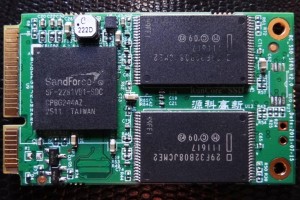INTERIOR COMPONENTS
The Runcore T50 SATA 3 mSATA 120GB SSD is assembled on a printed circuit board (pcb) which measures 51mm x 32mm x 4mm and weighs under 30 grams. The easiest way to understand how small this is has been depicted in the phot on the first page of this report. It is exactly 1/3rd the size of the typical business card. On the drive is the SandForce SF-2281 SATA 3 processor and four modules of Intel IMFT 25nm NAND flash memory (29F32B08JCME2), each being 32GB in capacity.

 This totals 128GB of RAW capacity, however, 8GB is utilized by SandForce for its formware and overprovisioning needs. Final formatting brings the drive down even further leaving the end user with 112GB of available storage. For those wondering what IMFT stands for, it is ‘Intel/Micron Flash Technology and it is pretty interesting to note that all Intel and Micron flash is of the exact same physical make-up although both companies are competitors.
This totals 128GB of RAW capacity, however, 8GB is utilized by SandForce for its formware and overprovisioning needs. Final formatting brings the drive down even further leaving the end user with 112GB of available storage. For those wondering what IMFT stands for, it is ‘Intel/Micron Flash Technology and it is pretty interesting to note that all Intel and Micron flash is of the exact same physical make-up although both companies are competitors.
 The SSD also comes with a product decal which, if removed, immediately voids the manufacturers warranty.
The SSD also comes with a product decal which, if removed, immediately voids the manufacturers warranty.
BENCHMARK PROTOCOL AND THE TEST BENCH
 This is The SSD Review Test Bench Number One. A quick click on the photo will give you a better look.
This is The SSD Review Test Bench Number One. A quick click on the photo will give you a better look.
In testing, our main objective is to obtain results as pure and as accurate as possible and we want to ensure that no anomolies slip through. Simply put, we want to provide you with the absolute best results the tested hardware can provide. Repetition in testing is standard and, if necessary, we may conduct specific tests in Windows 7 safe mode to ensure the OS has little to no influence on the end result.
In order to validate and confirm our findings, testing is supported by industry accepted benchmark programs. All results are displayed through capture of the actual benchmark for better understanding of the testing process by the reader.
 We would like to thank Gigabyte, Corsair, MSI, OCZ, Fractal-Design, and Icy Dock for sponsoring components of our Test Bench.
We would like to thank Gigabyte, Corsair, MSI, OCZ, Fractal-Design, and Icy Dock for sponsoring components of our Test Bench.
SSD COMPRESSION AND TESTING FLUCTUATIONS
All SSDs are not created equal and many new SSD enthusiasts realize that when they test their new drive to confirm specifications and ensure all is in order. SandForce controlled SSDs use compression techniques in storage whereas many others do not. This creates a bit of confusion when enthusiasts test the drive with random data through benchmarking programs such as AS SSD and Crystal Diskmark (random data sample). The results seem to be lower than the listed specifications.
The results actually present a false portrayal of the drives ability when compared to other drives such as the Samsung 470 Series and Crucial M4 SSDs that we have reviewed previously. It is for this reason that all of our comparison testing is done through PCMark Vantage. PCMark Vantage HDD Suite simply provides evaluation results based on transfer speeds reached through typical user patterns. Vantage provides a better testing medium, in that, it sees through the typical synthetic benchmarks and provides us with true to life results of the drive.
BENCHMARK SOFTWARE
Software used for testing by The SSD Review consists of Crystal DiskMark, ATTO Benchmark, Anvil Storage Utilities, HDTune Pro along with FutureMark PCMark Vantage.
All do a great job of showing us the numbers that we want to see, or dont want to see in some cases, while PCMark Vantage x64 is an excellent program which recreates tests that mimic the average users activity, all the while providing a medium to measure each.
INDEX
Pg1 – Introduction, Compatibility & Packaging
Pg2 – Internals, Test Bench & Testing Protocol
Pg3 – ATTO, Crystal Disk Mark and Anvil Storage Utilities
Pg4 – HDTune Pro Benchmarks
Pg5 – PCMark Vantage Testing, mSATA SSDs Compared & The SSD Hierarchy
Pg6 – The Verdict
 The SSD Review The Worlds Dedicated SSD Education and Review Resource |
The SSD Review The Worlds Dedicated SSD Education and Review Resource | 